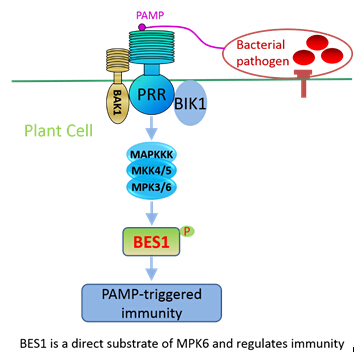Pathogen-associated molecular patterns (PAMPs) are recognized by plant pattern-recognition receptors (PRRs) to activate PAMP-triggered immunity (PTI). PTI confers broad and most durable resistance, and is the first layer of defense against the majority of microbial pathogens.
Jie Zhang youth group at Institute of Microbiology identified a novel transcription factor, BES1, in PAMP-triggered immunity signaling. The authors showed that PAMP perception enhances phosphorylation of BES1 through pathogen-induced MAPKs in plant cells. BES1 interacts with MPK6 (MAP kinase 6), and is phosphorylated by MPK6. bes1 mutants display compromised resistance to bacterial pathogen Pseudomonas syringae pv. tomato DC3000. BES1SSAA (BES1 S286A/S137A double mutation) impairs PAMP-induced phosphorylation and fails to restore bacterial resistance in bes1 mutant, indicating a positive role of BES1 phosphorylation in plant immunity. The results demonstrated that BES1 is a direct substrate of MPK6 and regulates plant immunity.
BES1 is also a key transcription factor in brassinosteroid (BR), an important plant hormone, signaling pathway. BES1 is phosphorylated by glycogen synthase kinase-3 (GSK3)-like kinase BIN2. BR perception inhibits BIN2 activity, allowing dephosphorylation of BES1 to regulate plant development. However, BES1SSAA does not affect BR-mediated plant growth, suggesting differential residue requirements for the modulation of BES1 phosphorylation in PTI and BR signaling. This study indicates differential modulation of a common transcription factor targeted by distinct signaling proteins in hormone and immunity signaling in plants.
The article describing this work was published online in Plant Physiology in March 2015. Youth group leader Jie Zhang is the corresponding author of the article. The work was supported by grants from the Strategic Priority Research Program of the Chinese Academy of Sciences (XDB11020600) and Chinese Natural Science Foundation (Grant 31300234).
Article link:http://www.plantphysiol.org/content/167/3/1076.full
